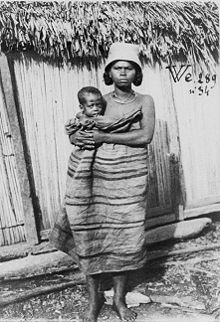Tanala: Difference between revisions
embed {{Authority control}} with wikidata information |
m copyedit, already indirectly in category, refine cat, and AWB general fixes using AWB |
||
| Line 16: | Line 16: | ||
Several Tanala rulers trace their lineage back to [[Antaimoro]] ''ombiasy'' (wisemen) who migrated to the area after 1550.{{sfn|Ogot|1992|p=855}} |
Several Tanala rulers trace their lineage back to [[Antaimoro]] ''ombiasy'' (wisemen) who migrated to the area after 1550.{{sfn|Ogot|1992|p=855}} |
||
In the |
In the 18th century the Tanala led a bloody conquest of the eastern coast.{{sfn|Ogot|1992|p=880}} Their major crops are coffee and rice. Recently, researchers have suggested that the Tanala are not truly a separate ethnic group.{{sfn|Bradt|Austin|2007|p=29}} |
||
<!--Ethnic identity |
<!--Ethnic identity |
||
| Line 43: | Line 43: | ||
{{Authority control}} |
{{Authority control}} |
||
[[Category:Ethnic groups in Madagascar]] |
[[Category:Ethnic groups in Madagascar]] |
||
{{Africa-ethno-group-stub}} |
{{Africa-ethno-group-stub}} |
||
Revision as of 03:35, 26 September 2015
 Tanala woman and child | |
| Regions with significant populations | |
|---|---|
| Madagascar | |
| Languages | |
| Malagasy | |
| Related ethnic groups | |
| Other Malagasy groups; Austronesian peoples |

The Tanala are a Malagasy ethnic group that inhabit a forested inland region of south-east Madagascar near Manakara. Their name means "people of the forest."[1] Tanala people identify with one of two sub-groups: the southern Ikongo group, who managed to remain independent in the face of the expanding Kingdom of Imerina in the 19th century, or the northern Menabe group, who submitted to Merina rule.[2] In 2013, the Tanala numbered around 400,000 people.[3]
The Tanala speak a dialect of the Malagasy language, which is a branch of the Malayo-Polynesian language group derived from the Barito languages, spoken in southern Borneo. Among the Tanala it is traditional to keep the body of a deceased individual for a month or more; the dead are then buried in the forest in coffins carved from large logs, with sacrifices to mark the cutting of the log and indications carved into a tree to indicate the location of the burial.[2]
Several Tanala rulers trace their lineage back to Antaimoro ombiasy (wisemen) who migrated to the area after 1550.[4] In the 18th century the Tanala led a bloody conquest of the eastern coast.[5] Their major crops are coffee and rice. Recently, researchers have suggested that the Tanala are not truly a separate ethnic group.[2]
Notes
- ^ Bradt & Austin 2007, p. 28.
- ^ a b c Bradt & Austin 2007, p. 29.
- ^ Diagram Group 2013.
- ^ Ogot 1992, p. 855.
- ^ Ogot 1992, p. 880.
Bibliography
- Bradt, Hilary; Austin, Daniel (2007). Madagascar (9th ed.). Guilford, CT: The Globe Pequot Press Inc. pp. 113–115. ISBN 1-84162-197-8.
{{cite book}}: Invalid|ref=harv(help) - Diagram Group (2013). Encyclopedia of African Peoples. San Francisco, CA: Routledge. ISBN 9781135963415.
{{cite book}}: Invalid|ref=harv(help) - Ogot, Bethwell A. (1992). Africa from the Sixteenth to the Eighteenth Century. Paris: UNESCO. ISBN 9789231017117.
{{cite book}}: Invalid|ref=harv(help)
